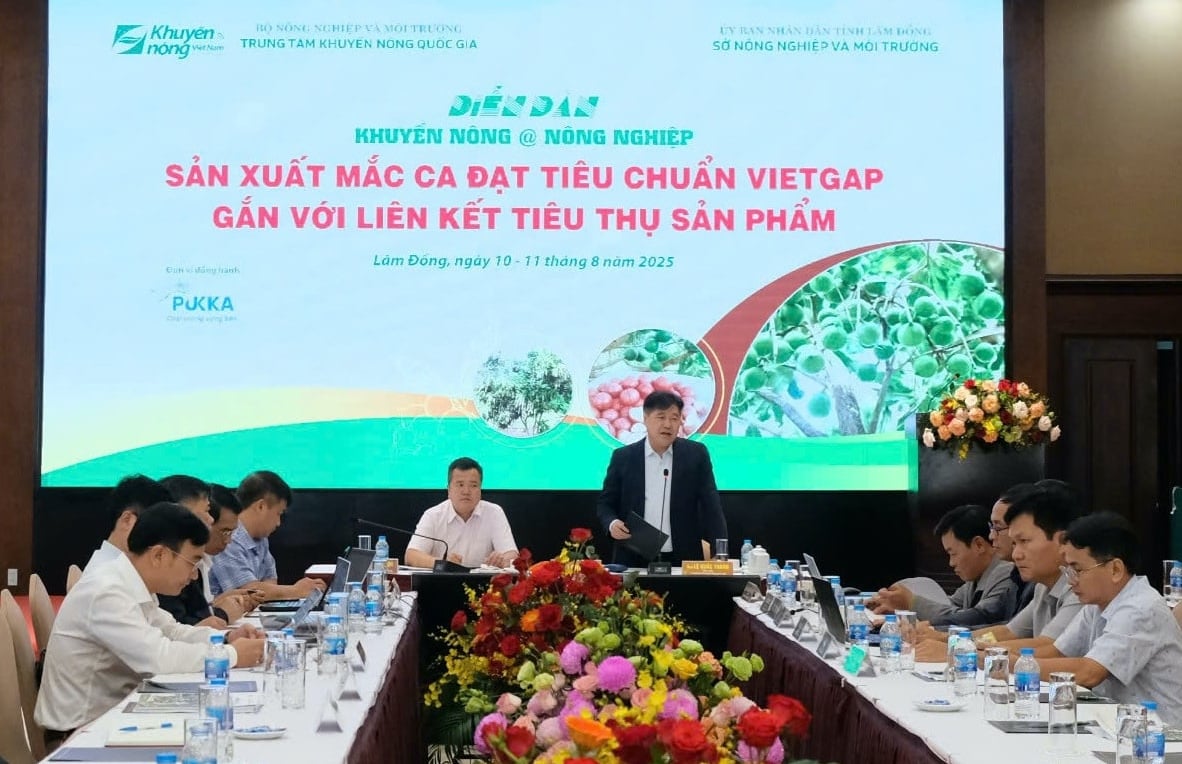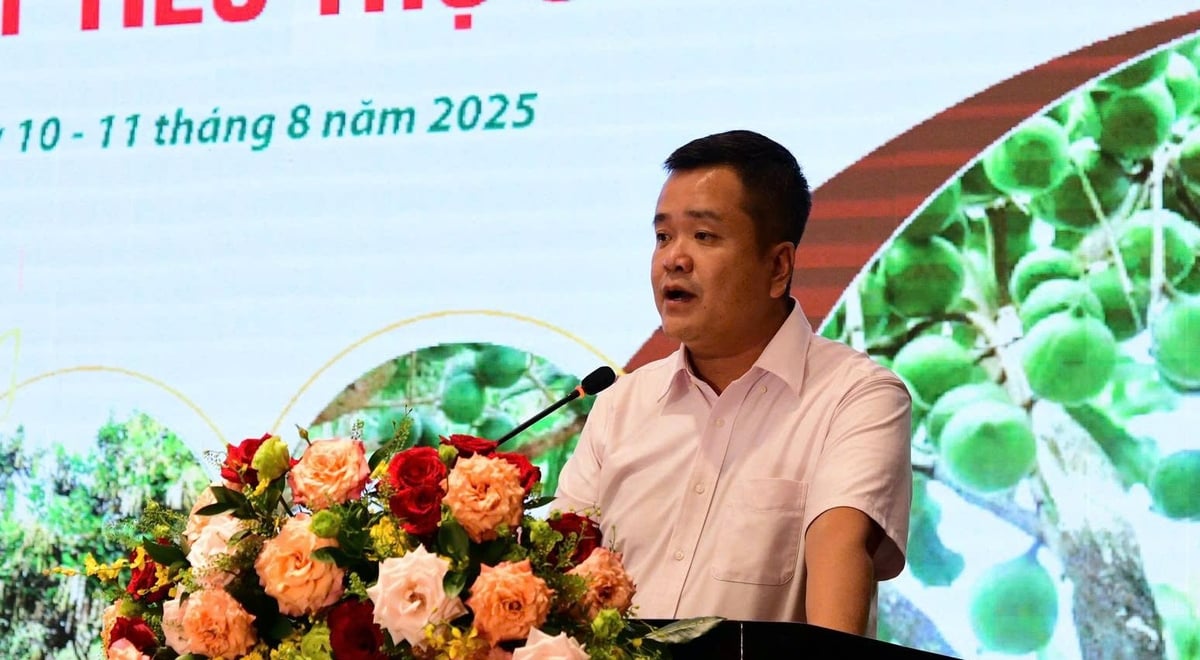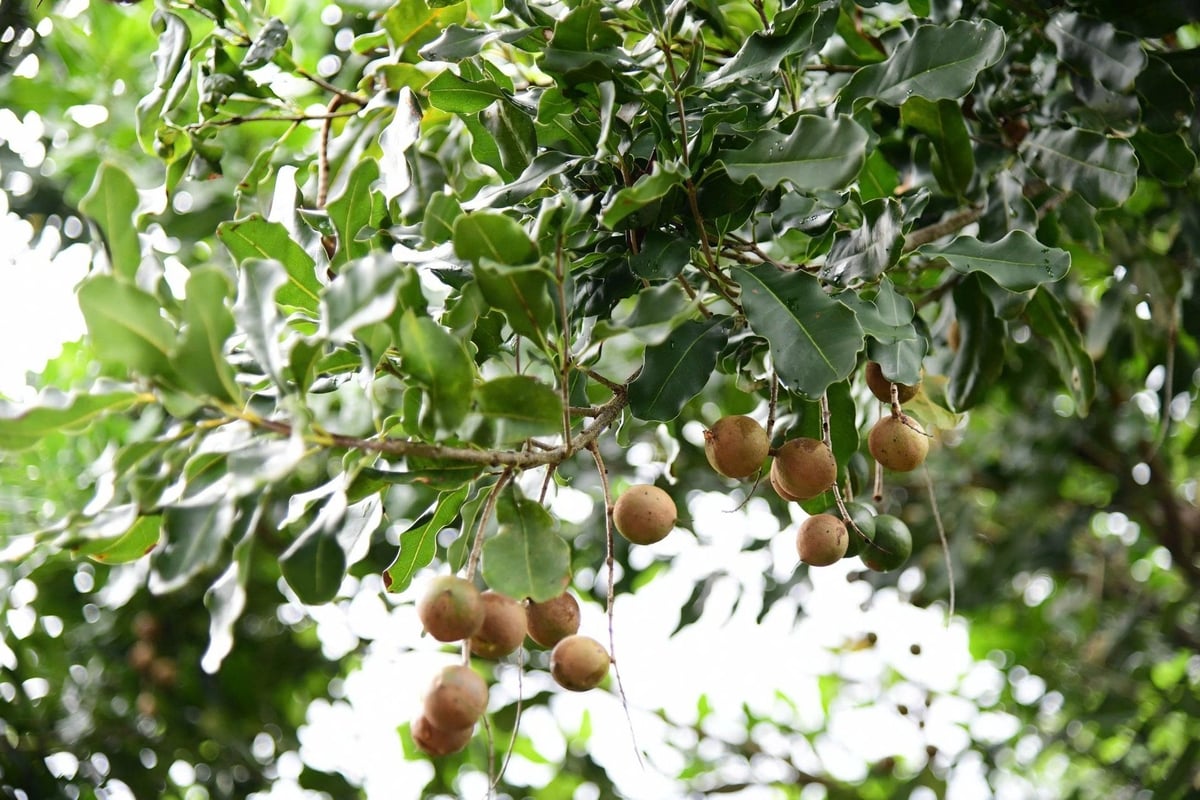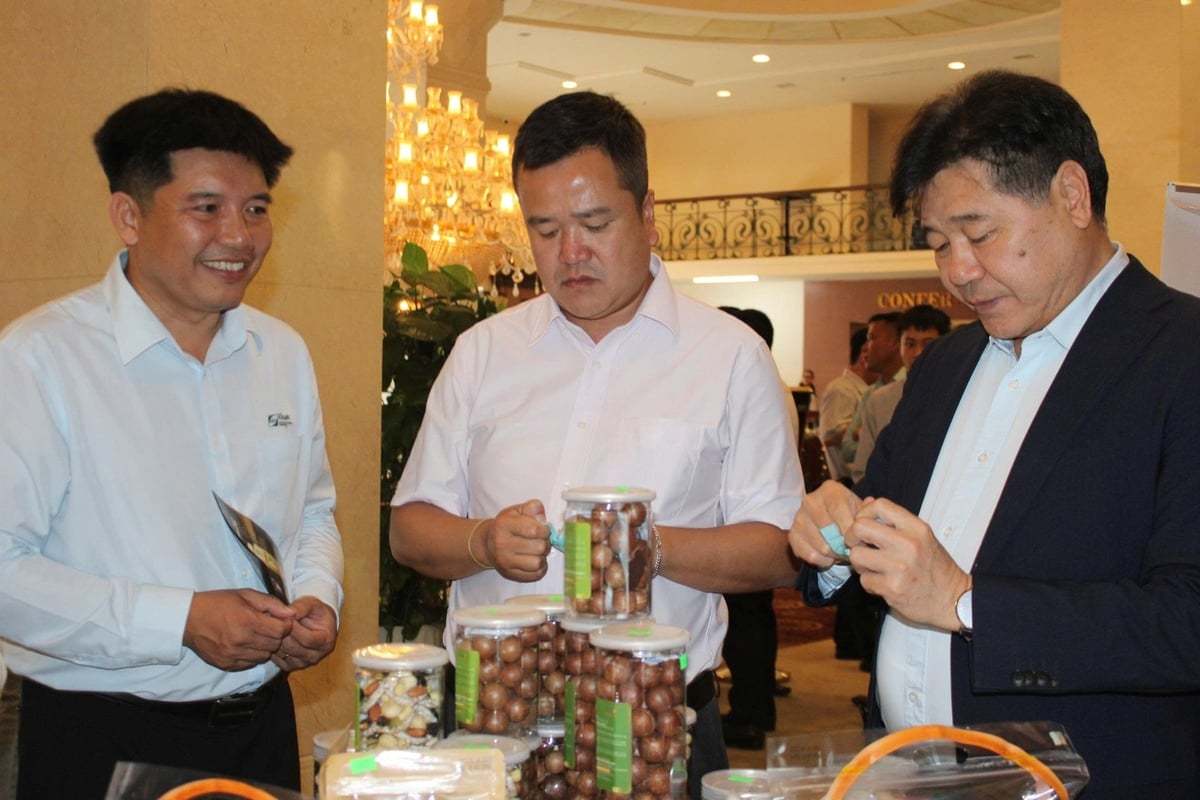December 11, 2025 | 00:58 GMT +7
December 11, 2025 | 00:58 GMT +7
Hotline: 0913.378.918
December 11, 2025 | 00:58 GMT +7
Hotline: 0913.378.918
On August 11 in Lam Dong province, the National Agricultural Extension Center, in coordination with the Lam Dong Provincial People’s Committee, held the “Agricultural Extension @ Agriculture” Forum themed “Producing macadamia to VietGAP standards linked with product consumption.”

Mr. Le Quoc Thanh, Director of the National Agricultural Extension Center, said macadamia has brought many benefits in terms of economy, environment, and employment for ethnic minority communities. Photo: VL.
The forum aimed to review the implementation results of the project “Sustainable Development of Macadamia 2021–2030, with a Vision to 2050” and to outline directions for establishing a sustainable macadamia sector in the coming years.
According to Nguyen Huy Thuan, Deputy Head of the Crop and Forestry Extension Division under the National Agricultural Extension Center, by the end of 2024, the country’s macadamia cultivation area had reached over 46,200 hectares. The Central Highlands alone accounted for more than 27,300 hectares, including nearly 16,000 hectares in Lam Dong and over 7,000 hectares in Dak Lak.
In recent years, macadamia has been recognized as a high-potential crop in midland and mountainous regions, especially in the Central Highlands and Northwest, where climate and soil conditions are favorable. With its high commercial value and rising international demand, macadamia is being positioned as a strategic crop in agricultural restructuring, linked with the development of concentrated raw material zones, deep processing, and export.
However, macadamia production still faces significant limitations, mainly due to its small-scale, scattered household-based cultivation, uneven farming techniques and orchard management, and a low proportion of areas certified under VietGAP or organic standards. Many processing facilities remain small-scale, with simple technology that falls short of stringent market requirements. The linkages between production and consumption stages are still weak, while traceability and brand building have yet to receive sufficient attention.
Meanwhile, global demand for macadamia continues to grow strongly, especially in Asia, Europe, and the United States. Consumers increasingly require products that meet quality standards, carry certifications, have clear origins, and are produced in an environmentally friendly manner. Therefore, organizing macadamia production in line with VietGAP standards and establishing stable consumption linkages will not only help increase product value but also serve as a decisive factor for the sustainable development of the sector.

Mr. Nguyen Ha Loc, Deputy Director of the Lam Dong Department of Agriculture and Environment, said the province will plan suitable macadamia-growing areas, organize production in concentrated raw material zones linked with enterprises, and develop sustainable value chains. Photo: VL.
Mr. Nguyen Ha Loc, Deputy Director of the Lam Dong Department of Agriculture and Environment, said the province currently has nearly 16,000 hectares of macadamia, of which 6,600 hectares are in harvest, with 2025 output estimated at 13,700 tons, up 48% from 2024.
Following administrative mergers, Lam Dong aims by 2030 to expand macadamia cultivation to about 37,000 hectares with an annual output of 48,000 tons, of which over 90% will be pre-processed or processed. By 2050, the target is 50,000 hectares producing 90,000 tons, establishing a complete value chain from seed production to deep processing and export.
The province will zone suitable growing areas, organize production in concentrated raw material zones linked with enterprises, develop sustainable value chains, and propose integrated policy support for macadamia development, especially in remote, ethnic minority areas.
According to the National Agricultural Extension Center, many macadamia farming models have applied advanced techniques such as high-quality grafted varieties, twin-row planting, efficient irrigation, balanced fertilization, and integrated pest management. These practices have helped raise average yields to 1–1.5 tons of dry nuts per hectare, with some intensive farming areas exceeding 3 tons per hectare.

In recent years, macadamia cultivation has helped many farmers in remote, disadvantaged, and especially difficult areas escape poverty. Photo: VL.
Production – processing – consumption linkages have begun to form in many areas. Some cooperatives have signed product purchase contracts with businesses, organizing activities from supplying seedlings and materials, transferring techniques, to purchasing and processing. Many companies have invested in facilities for preliminary processing, roasting, shelling, and oil pressing of macadamia nuts, helping increase value and expand export markets.
According to the Vietnam Macadamia Association, in 2024, the country exported about 500–600 tons of macadamia kernels, mainly to China, Japan, South Korea, and Europe. Conversely, Vietnam still imported 3,500–4,000 tons of raw macadamia nuts from South Africa, Australia, Kenya, and others for processing and domestic consumption. This shows that while the domestic market has great potential, local products are not yet competitive enough in terms of quantity, quality, and price.
In Lam Dong, the National Agricultural Extension Center is implementing the project “Developing intensive macadamia cultivation models under VietGAP standards linked with product consumption in several Central Highlands provinces,” covering 70 hectares with 140 participating households. The project supports materials, VietGAP certification costs, planting area codes, labels, and provides technical training to over 780 farmers. It also establishes community agricultural extension teams and two cooperative-business linkage models to ensure full purchase of the output.

Delegates visit the macadamia nut product display booth at the forum. Photo: VL.
Mr. Le Quoc Thanh, Director of the National Agricultural Extension Center, stated that macadamia has brought significant economic, environmental, and employment benefits to ethnic minority communities. However, to expand cultivation areas and ensure sustainable development, the entire value chain of this sector needs to be repositioned.
“Farmers need to review planting area plans, select appropriate varieties, and follow proper cultivation processes. Enterprises must invest adequately in raw material zones, closely link with farmers, and develop their own growing regions,” Mr. Thanh emphasized.
Mr. Le Quoc Thanh warned that neglecting pest control and ensuring the safety of input materials will make it difficult for products to access international markets. Therefore, the National Agricultural Extension Center will continue to coordinate with localities to develop model farms that meet standards, connect with businesses, and build a sustainable, environmentally friendly, and globally competitive macadamia value chain.
Translated by Phuong Linh

(VAN) According to Deputy Minister Nam, women are as capable as anyone when granted the opportunity to experiment and innovate.

(VAN) Dr. Fred Unger, former Regional Representative of ILRI in Asia, is honored as a pioneering expert who helped establish Viet Nam’s One Health and risk-based approaches in food safety.

(VAN) By joining the carbon market, Hoang Lien National Park can reinvest revenues into conservation and improving community livelihoods.

(VAN) Bach Ma National Park will continue to conserve biodiversity in ASEAN, aligned with sustainable agriculture and environmental development goals.

(VAN) Pu Mat National Park is a green gem of Nghe An province, and its value is further elevated after being officially recognized as an ASEAN Heritage Park.

(VAN) EU expects Viet Nam to seize the chance and comply with green standards to make strong breakthroughs in exporting high-quality agricultural products.

(VAN) These meaningful messages from international partners affirm VAN News' increasingly solid standing.